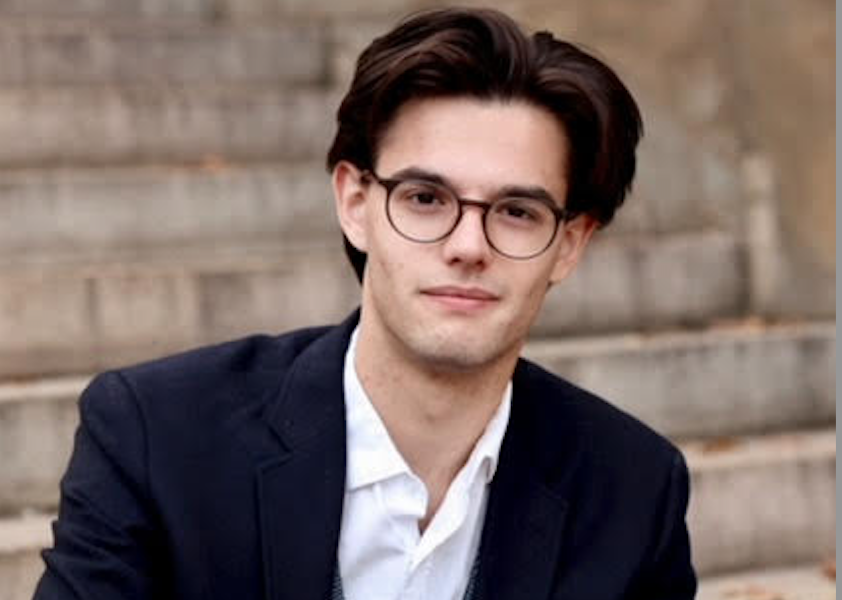Pianist Thomas Nickell in Review
Thomas Nickell, piano
Tenri Cultural Institute New York, NY
September 17, 2023
It is always interesting, after one has reviewed a young student, to review that same performer some years later. Five years ago, I reviewed a very young Thomas Nickell in a program at Zankel Hall that included Beethoven’s Piano Concerto No. 2, Liszt’s Totentanz, and a composition by Mr. Nickell himself. He was on a dual path as a double major in piano and composition at The New School, Mannes College of Music (from which he now holds double B.M. degrees), but he had struck this listener at the time as being primarily a pianist who happened also to compose. Five years later (though still young!), with some more compositions, premieres, albums, and ballet company collaborations under his belt (including with the illustrious Pacific Northwest and Joffrey Ballet companies), he projects the opposite impression – that of a composer who also plays the piano, but much better than composers typically do. This is not to say that one needs to choose, because there is a synergy that happens by combining performing and composing – but each art can be “a jealous mistress” as the saying goes, so prioritizing can be helpful in building programs and ultimately in following one’s heart.
One had a sense that Mr. Nickell was following his heart and in complete comfort with his choice of the Satie Sarabande No. 1. It was a wonderful piece to precede Mr. Nickell’s own Sonata, as it readied the listeners’ ears for something fresh, new, and highly individual. It is funny that one can barely enter certain coffee shops without hearing Satie’s Gymnopedies, but the three Sarabandes have been relatively underplayed, so it was good to hear Mr. Nickell’s probing and sensitive rendition.
It was also a joy seeing on the program the solo version of Poulenc’s Aubade, Concerto Chorégraphique (1929), which closed the evening. Though created by Poulenc himself from a ballet he had conceived, it has yet to gain currency as a piano work. Especially effective was Mr. Nickell’s fiery and fleet fingerwork in both the Toccata and the Allegro Féroce movements. The Andante – Variation de Diane, a meltingly lyrical movement, was given the sensitive devotion it needs and deserves. Bravo! Oddly, this movement wasn’t listed as the Variation de Diane, nor was there any mention of the story of the goddess Diana – the inspiration behind the work. Without a ballet to project the story, some brief program notes could have certainly helped guide listeners. Especially curious was their absence in view of the fact that there were notes for the four very famous Chopin works on the program.
Newer still than Poulenc or Satie was Mr. Nickell’s own Sonata, which was given its world premiere during the first half, to a reception of the pianist’s cheering fans. Though this listener could have used more illumination to help knit together its chromaticism and thorny beginning with other sections, plus the brief appearance of a nostalgic waltz later on in the piece (is there a story there?), it contained many ideas one could find engaging (even if the composer himself, reading from an electronic score, needed a degree more of engagement at times). Also engaging was a movement called Silver Lake from the composition Scenes from My Childhood by Cameron Smith, about whom there were no biographical notes. Ms. Smith’s piece employs extended techniques (plucked lower strings inside the piano), to evoke the depths of the remote lake for which her piece is named. Mr. Nickell played it with a persuasive dreamlike quality.
Last of all to discuss, yet spread throughout the program and dominating it timewise – were four of Chopin’s most revered and frequently performed works, including two Ballades (No. 1 in G minor and No. 4 in F minor) and two Scherzi (No. 1 in B minor and No. 2 in B-flat minor). In these, Mr. Nickell acquitted himself well overall, but, given the immense stature of these pieces in the piano world and their very rich performing histories, it seems that programming these was not the best representation of Mr. Nickell’s considerable gifts. Though there were glimmers of magic where Mr. Nickell took more time than many pianists do to highlight certain inner voices and progressions, there were also a few too many details obscured or glossed over (a quibble mentioned also in my 2018 review) – and one hesitates even to use such a potentially dismissive term as “detail” in discussing the finely wrought creations of Chopin.
Aside from some overlooked articulations, pedal blurring where clarity was needed, and lost textures (generally in the left hand), there was the occasional need for more attention to cantabile treble lines, which need to soar and ring out at phrase peaks. Pianists tend to live for such lines in Chopin, but perhaps Mr. Nickell was pre-emptively overcompensating for the notoriously harsh sound of the piano and acoustics of this venue, the Tenri Cultural Institute (and Tenri has been cited repeatedly for the harsh sound by reviewers from New York Concert Review). To Mr. Nickell’s credit, there was not a single harsh sound, neither in the bracing opening chords of the Scherzo in B minor (nor their return after the B major section), nor in the climaxes of the other pieces. Oddly, one might have willingly endured just a touch of harshness here and there, in pursuit of unleashing the big spirit in these great works – though it is of course hard addressing so many issues at once and finding the right balance.
Projection, and the practice of thinking outwardly as a performer, may not be easy to combine with the introspection involved in composing, so it is undoubtedly a challenge to straddle two such demanding artistic pursuits; it is clear, however, that Mr. Nickell has the talent and potential to take on enormous challenges, so we’ll look forward to his next chapter.

